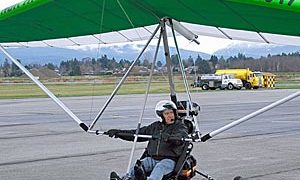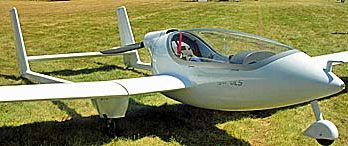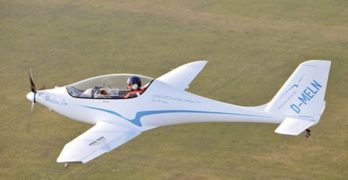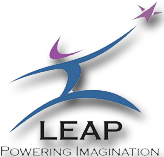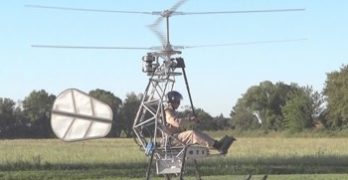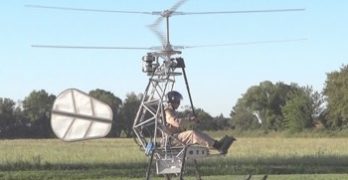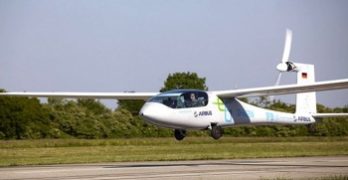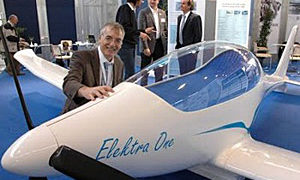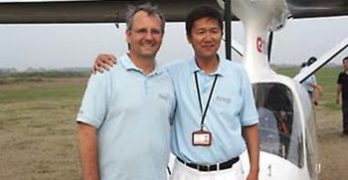From the land of sky-blue waters comes … no, not a beverage but Canada’s first electric ultralight. And sky-blue waters aren’t the point; instead, it’s all about blue skies and getting up to them for a bit of soaring fun. Thanks to my journalist friend Russ Niles, Editor-in-Chief of AvWeb (one of my favorite aviation websites), I heard about a Canadian friend who’s done some interesting development work. Given the general excitement about electric power and my personal interest in soaring flight, I called up my old friend.
Like many of us who enjoy soaring hang gliders, developer Randy Rauck said, “I always wanted to apply electric to a lightweight trike so we could quickly and easily fly our hang gliders up to where the thermals abound.” When he’s not creating a new powerplant Randy runs the Freedom Flight Park in Lumby, BC Canada. “I wanted to try electric to get away from the vibration of a lightweight two-stroke gasoline engine.
Search Results for : Electric
Not finding exactly what you expected? Try our advanced search option.
Select a manufacturer to go straight to all our content about that manufacturer.
Select an aircraft model to go straight to all our content about that model.
Electric! Gorgeous! Freedom! …4th Generation ULS
Randall Fishman virtually invented the electric aircraft. That’s a rather big statement yet I stand behind it. Randall first showed a functional electric trike at Oshkosh 2007. He’s been on a tear ever since and his ULS is his present state-of-the-art, his fourth generation of electric aircraft design.
*** I use three words to describe ULS deliberately. It’s electric. That’s obvious but singular. Fishman’s Electric Aircraft Corporation is presently selling electric powered aircraft. You can also buy an electric eSpyder from Yuneec or an eGull from Earthstar but after that, mostly what you hear about electric aircraft are developments… fascinating but just developments. Electric Aircraft Corporation is ready today.
*** ULS is gorgeous. You can see that for yourself and I have to presume you agree because it is simply beautiful in its sweeping lines, slippery smoothness, and overall elegance. It wowed visitors to Oshkosh 2012 and it’ll do that at any airport I submit.
Electric-Powered Light Aircraft
Flying with Juice
As an airplane approaches, a whirring sound accompanied by a
barely discernible whine and a mild propeller buzz exhibit a
Doppler effect as the plane passes overhead. What is that curious noise?
We are intimately attuned to internal combustion engine sounds –
some experts claim they can identify the brand and size of an engine
simply by listening to it run. We’re less aware of electric motor noises
because we quickly tune them out. Electric motors run everywhere in
our lives – in our refrigerators, our computers, in our ceiling fans, and
numerous other appliances. Most motors – it’s incorrect to call them an
“engine” – are exceptionally quiet, and that’s a good thing.
One wonders if relatively quiet electric motors on aircraft will invade
our piston-powered world, especially given noise sensitivity at many airports.
Some say, “We’re about to see if electric works.” I say, “We’re seeing
it right now!”
Two years ago, I wrote about ultralights – literally Part 103-compliant
ultralights – operating remarkably well on electric power.1 In the ensuing
months, more projects have been announced.
Electric Aircraft Development Alliance Takes Form
A wide range of people sat in a room used all day long by the ASTM Committee that develops the LSA certificate standards. Apparently sitting in a room all day — while the sun shown brightly and the flying would have been great — was not enough punishment for this hard working crowd. Indeed, nearly 30 persons willingly stayed into the evening. What drove such dedication? Electric-powered aircraft. *** The G-30 assembled to work at forming the Electric Aircraft Development Alliance (EADA), a brand new industry organization specifically aimed at electric-powered aircraft. Representatives came from Sikorsky, Yuneec, Pipistrel, Sonex, Alternair, Electra One, Cessna, Bye Aerospace, Lockwood Aircraft, Embry Riddle, FAA, EASA, LAMA, and others. LEAP, the Lindbergh organization, lent energy to help assemble the group and, indeed, they drew a number of people that had not traveled to Tampa, Florida for the ASTM meeting.
Electric Whirlybird Flies!
Anyone still in doubt that we’re in the midst of the birth of electric flight need look no further than this story, just posted today on the online tech zine Gizmag.Pascal Chretien, an enterprising electrical/aerospace engineer and chopper pilot, made the world’s first fully electric helicopter flight in the prototype he designed and built almost entirely by himself…in just 12 months! Hang glider and ultralight trike pilots will delight in hearing a weight shift control system is involved. *** For me, the big story here is once again we see that innovation lives, not just in megabuck corporate and government R&D departments but in the garages of individual megabrains as well…as it always has and we can expect always will.Chretien, in making his 2 minute, 10 second test eggbeater flight, threw whipped eggs in Sikorsky’s face since that aviation giant’s well-funded electric project, in development for some time now, has yet to fly.
Electric Whirlybird Flies!
Anyone still in doubt that we’re in the midst of the birth of electric flight need look no further than this story, just posted today on the online tech zine Gizmag.Pascal Chretien, an enterprising electrical/aerospace engineer and chopper pilot, made the world’s first fully electric helicopter flight in the prototype he designed and built almost entirely by himself… in just 12 months! Hang glider and ultralight trike pilots will delight in hearing a weight shift control system is involved. *** For me, the big story here is once again we see that innovation lives, not just in megabuck corporate and government R&D departments but in the garages of individual megabrains as well…as it always has and we can expect always will.Chretien, in making his 2 minute, 10 second test eggbeater flight, threw whipped eggs in Sikorsky’s face since that aviation giant’s well-funded electric project, in development for some time now, has yet to fly.
eWow! Blockbuster Electric Flight
A crack team of aeronautical whizbrains in the Institute of Aircraft Design at the University of Stuttgart, Germany has just passed its second important milestone in less than two months: its electric aircraft eGenius just flew more than two hours at more than 100 mph. *** Not by coincidence, that’s exactly the kind of performance that will be required to take $1.3 million top prize in the recently postponed (until September 25) CAFE Green Flight Challenge. *** The GFC will award the prize money to the aircraft that can fly 200 miles at greater than 100 mph on the equivalent of one gallon of gas per occupant. The per occupant proviso is significant…and EGenius carries two people, so it can use enough batteries to store two gallons worth of energy. *** That’s a lot of batteries given the current relative inefficiency of energy storage of batts vs.
EAA Electric Contest Postponed
Surprising word came today while hanging out at the Piper Sentimental Journey in Lock Haven, PA, that EAA has canceled its Electric Flight Challenge until next year’s AirVenture show to give manufacturers more time to satisfy FAA’s Phase 1 requirement. *** What’s Phase 1, you ask? Read on. Today’s release, announced the postponement even though there was “a strong influx of applications… nearly a dozen”, whatever that means — 11? 8.3? *** Anyway, a $60,000 Electric Flight Prize was to have been awarded after three flight competitions and an “innovation evaluation” at this year’s AirVenture (end of July). *** Now for Phase 1: EAA explains it’s the requirement for the normal 40-hour “fly off” period typically flown by experimentally-built kits, to verify the aircraft is safely controllable throughout its normal speed range and all expected maneuvers. *** Chairman Tom Poberezny was quoted as saying that, in essence, too many of the competitors wouldn’t have enough time to finish flying off their hours before the challenge began.
Electric Prototype and Pilot Lost
Electric Prototype and Pilot Lost
As I write an article on the current state of electric flight worldwide, sad word comes that prolific, talented German aeronautical engineer Martin Wezel has died in the crash of the prototype Yuneec International E1000 electric airplane. *** Wezel’s company, Flugzeugtechnik Wezel, was well respected for its gliders and microlights, which included the Sting and Sirius SLSA. His Apis and Viva designs were also being developed by Yuneec for electric power. The E1000 design may also have been Wezel’s. *** A new, tandem-motored four-seat design, it was being developed for market by Yuneec but also to compete in the NASA CAFE Green Flight Challenge, the $1.65 million-prize competition that’s coming up in July. *** E1000 was also entered in EAA’s upcoming Electric Aircraft Competition (Oshkosh 2011 in late July). Not evident at this point is whether another E1000 was built or will be tested.
- « Previous Page
- 1
- …
- 4
- 5
- 6
- 7
- 8
- …
- 67
- Next Page »


